
Fast, affordable Internet access for all.

Franklin, Kentucky expects to see more positive economic growth when it launches its new fiber optic network. According to an article in the Bowling Green Daily News, the south central community is ready for the upgrade:
“We are super excited about it,” said James McCaslin, associate vice president of academic affairs and director of Franklin-Simpson Center. “It will be like going from 1970 to 2013 with the flip of a switch.”
We contacted Tammie Carey, Fiber Services Manager for Franklin Municipal FiberNET, and she was good enough to answer some questions. She told us that 32 miles of aerial fiber are strung in three loops around the city to ensure redundancy. She expects the network to launch near the end of January for local businesses, though the utility has already been serving one business as detailed below.
The decision was based solely on a desire to boost economic development, a sentiment echoed in the Daily News article:
It’s hard to recruit industry now if you don’t have (fiber optics),” said Dennis Griffin, industrial recruiter for Simpson County. “A lot of industries, particularly in this area, are satellite plants connected to their corporate offices, somewhere else in the United States. They all need to be connected by fiber.
“So if you don’t have that, it’s hard to compete with communities that do,” Griffin said. “Ten years ago, you could get by with T-1 lines – now most industries are just expecting that you have fiber."
Apparently, City officials contacted AT&T and Comcast several years ago and asked them to install fiber to the Franklin industrial parks. When they refused, City Leaders began pondering the possibility of a municipal fiber network. Tammie tells us about the decision in an email:
Readers know we have offered extensive coverage of the publicly owned network in Longmont, Colorado. The utility will soon offer telecommunications services to businesses and residents that are physically located within 500 feet or less of its existing network. At this stage, policies and procedures for the service are being finalized by Longmont Power and Communications (LPC).
We talked with Vince Jordan, LPC's Telecom Manager, who told us the expansion is part of their original business plan. Local establishments are ready to sign up with LPC. Twenty businesses put themselves in the queue within the past month. In addition to industrial and manufacturing companies, healthcare clinics, service industries, and entrepreneurs are waiting to get hooked up. Vince tells us several companies are looking to build data centers now that they will be able to get the bandwidth they need from LPC.
Vince credits LPC's ability to offer great local customer service as another driving factor for the early sign-ups. LPC is developing a fiber hood campaign to determine the locations for the first set of FTTH connections. The campaign, similar to that used by other communities and more recently by Google, will look at residential areas that are located near existing fiber and conduit. Surveys and early sign ups will identify seven fiber hoods.
Longmont's ordinance [PDF] requires customers to cover the cost of running fiber to their homes or businesses. Even though connecting can be pricey, Vince tells us potential customers call him regularly asking when they will be able to get fiber to their homes or establishments.
Many residential inquiries involve home based businesses, but not all. He relays the story of one retired gentleman who is so fed up with sorry service from the incumbents, he is willing to pay anything up to $10,000 to get LPC fiber to his home. We have encountered many instances of crappy customer service from the big boys, leaving us to suspect others share that sentiment.

“We want to grow our own new businesses in Indianola, and Simpson College is home to an entire group of potential entrepreneurs who we hope will find support for their efforts here and some day choose to locate their businesses here,” [Jerry Kelly, former Indianola mayor and executive director of the city's development association] said. ‘What we are doing is called ‘economic gardening.’ What grows here will stay here.”
Thanks to the Indianola Municipal Utilities (IMU) next-generation broadband network, the city and the college have fertile soil to nurture that garden. We previously wrote about this FTTH partnership here, explaining that the community owns the infrastructure and a local business provides services over the network.
The partnership between Simpson College, the Indianola Development Association, and IMU is called the Indianola + Simpson College Entrepeneurial Devopment Initiative. The student-business incubator will bring together students, mentors, and existing businesses with the hope that resulting entrepeneurships will sprout and grow in Indianola.
Through the partnership, the incubator will have access to IMU's server platforms, wholesale bandwidth, local marketing and outreach efforts, and customer service activities. 25 students will develop senior Capstone Projects through the initiative. College and city leaders anticipate that number will continue to grow.

The Simpson College News Center also writes that the project will be led by Chris Draper. Draper is associated with Des Moines' Startup City, a technology-based business incubator. Draper is CEO of the first graduate of Startup City, Meidh Tech, which offers property management technology solutions.

Even as the Internet is changing every aspect of our lives and communities, most Americans are intimidated by confusing jargon and misconceptions about Internet policy. We are developing a series of fact sheets that make these issues understandable to everyone.
We presently have fact sheets from the Institute for Local Self-Reliance and other organizations that cover broadband, financing networks, wireless Internet, economic development benefits from community owned networks, and the public savings from community owned networks.
Stay up to date with these fact sheets and other developments in community owned networks, subscribe to our one-email-per-week list. Once a week, we send out an update with new stories and resources.
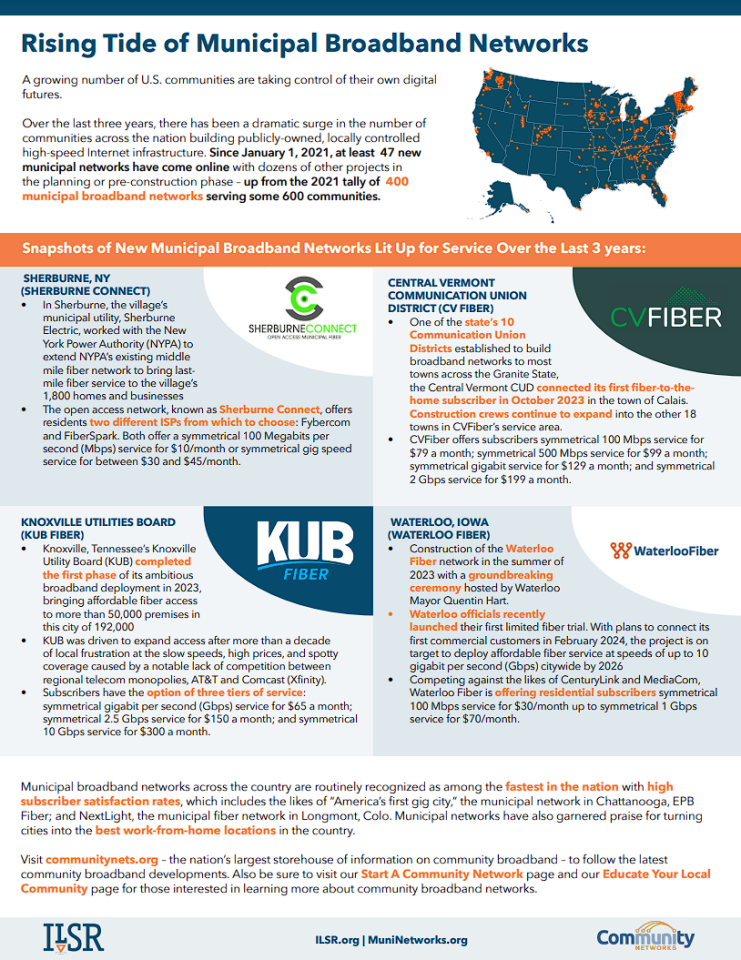
The municipal broadband movement continues to gain momentum. Since January 1, 2021, at least 47 new municipal networks have come online with dozens of other projects still in the planning or pre-construction phase, which includes the possibility of building 40 new municipal networks in California alone. To help encapsulate this dramatic surge in the number of communities building publicly-owned, locally controlled high-speed Internet infrastructure, we created this fact sheet to provide pertinent numbers and highlight four recently launched networks now providing service to communities hungry for high-quality Internet connectivity, choice, competition.
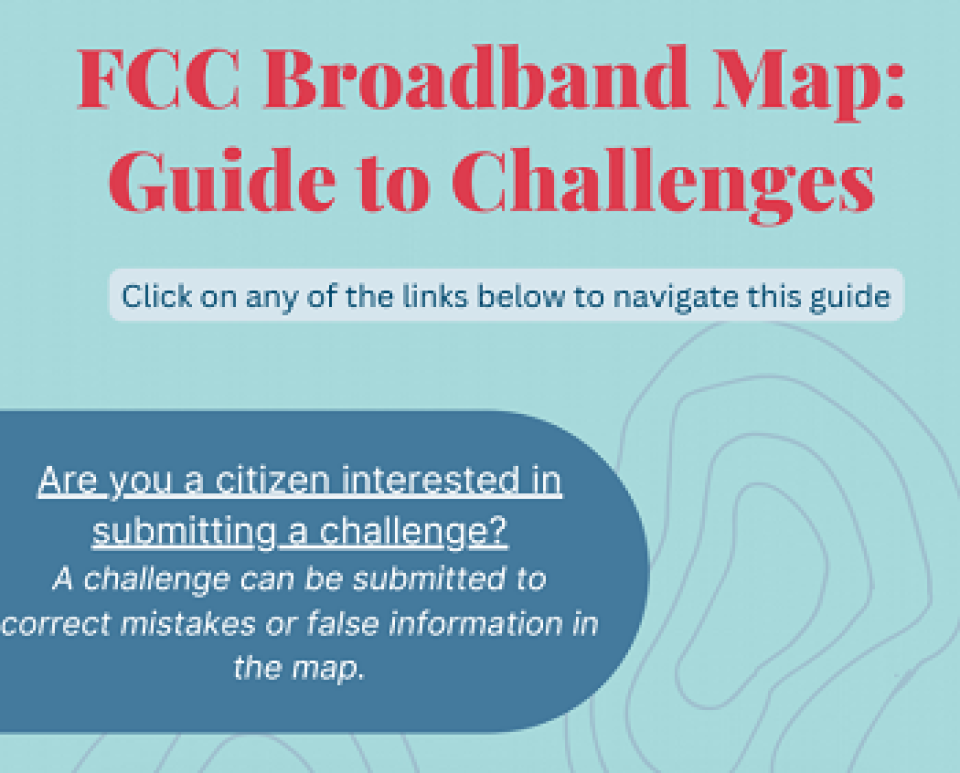
With good reason, many are confused about the information shown in the FCC's new Broadband Availability map, the challenge process, and why we should care about helping the FCC make corrections. We believe it is important to contribute to improving this map to enable an equitable allocation of Broadband Equity, Access, and Deployment (BEAD) Program funds to states next year. In an effort to provide a better understanding of the map itself and the challenge process we created a short series of instructional videos and a click-through guide. FCC Broadband Map Challenge Guide [pdf]
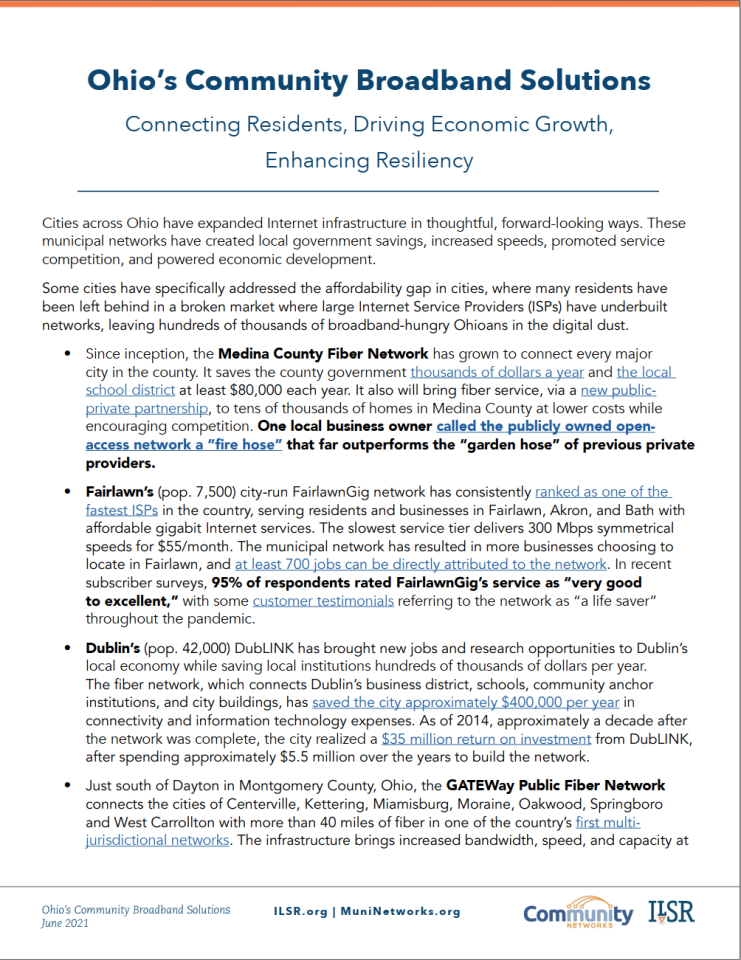
Cities across Ohio have expanded Internet infrastructure in thoughtful, forward-looking ways. These municipal networks have created local government savings, increased speeds, promoted service competition, and powered economic development. Some cities have specifically addressed the affordability gap in cities, where many residents have been left behind in a broken market where large Internet Service Providers (ISPs) have underbuilt networks, leaving hundreds of thousands of broadband-hungry Ohioans in the digital dust. This fact sheet outlines the many long-term benefits that municipal broadband projects have brought to the state.
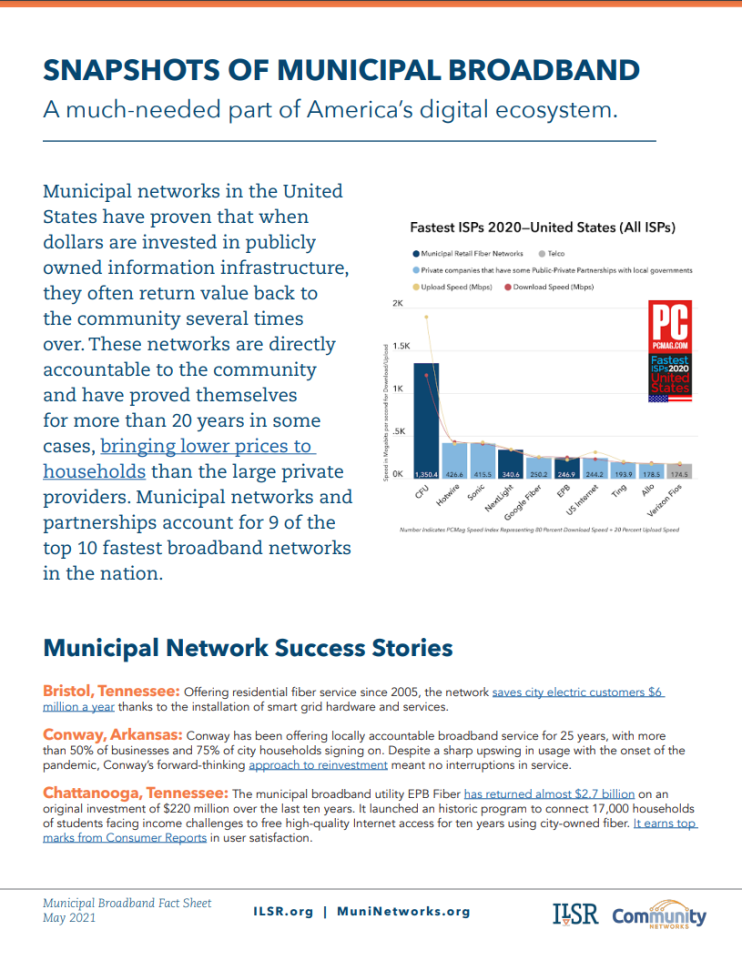
Municipal networks in the United States have proven that when dollars are invested in publicly owned information infrastructure, they often return value back to the community several times over. These networks are directly accountable to the community and have proved themselves for more than 20 years in some cases, bringing lower prices to households than the large private providers. Municipal networks and partnerships account for 9 of the top 10 fastest broadband networks in the nation. This new fact sheet highlights municipal broadband success stories from across the country and some of the many benefits the networks have brought to the communities they serve.
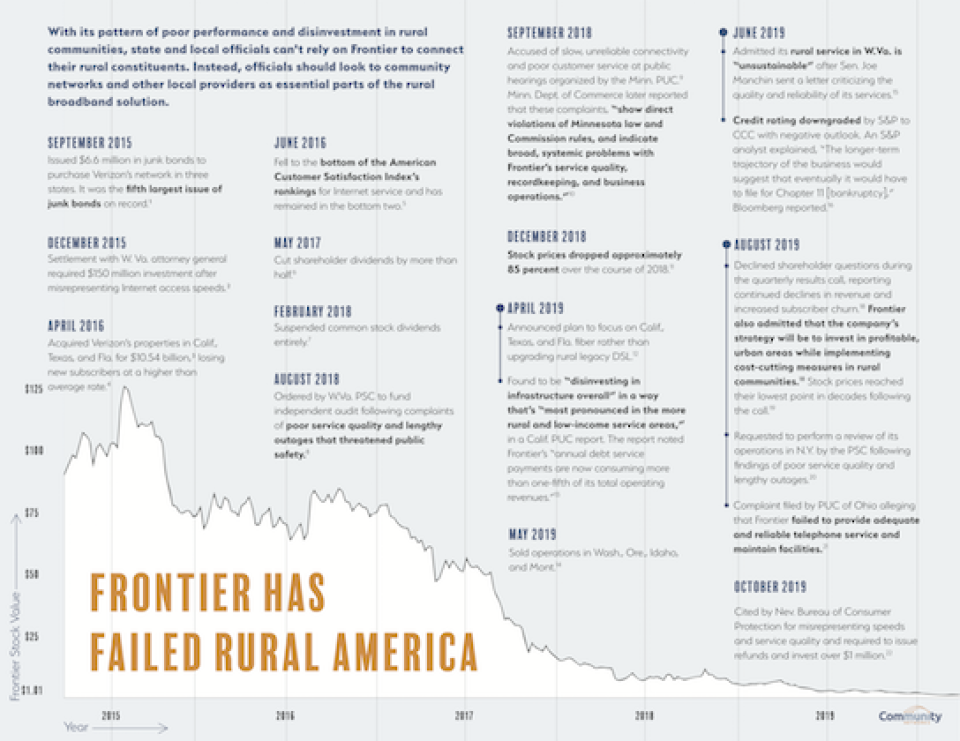
Despite raking in hundreds of millions in government broadband subsidies, Frontier Communications has failed time and time again to bring reliable, high-speed connectivity to the rural communities it serves. Instead of investing in network upgrades, Frontier has neglected its rural infrastructure to the detriment of its subscribers and the company’s own financials, with its worsening service quality paralleling its plummeting stock value. This fact sheet presents evidence of Frontier’s negligence and suggests that rather than continuing to trust Frontier, government officials should look to publicly owned and community-minded providers to connect rural residents, businesses, and institutions.
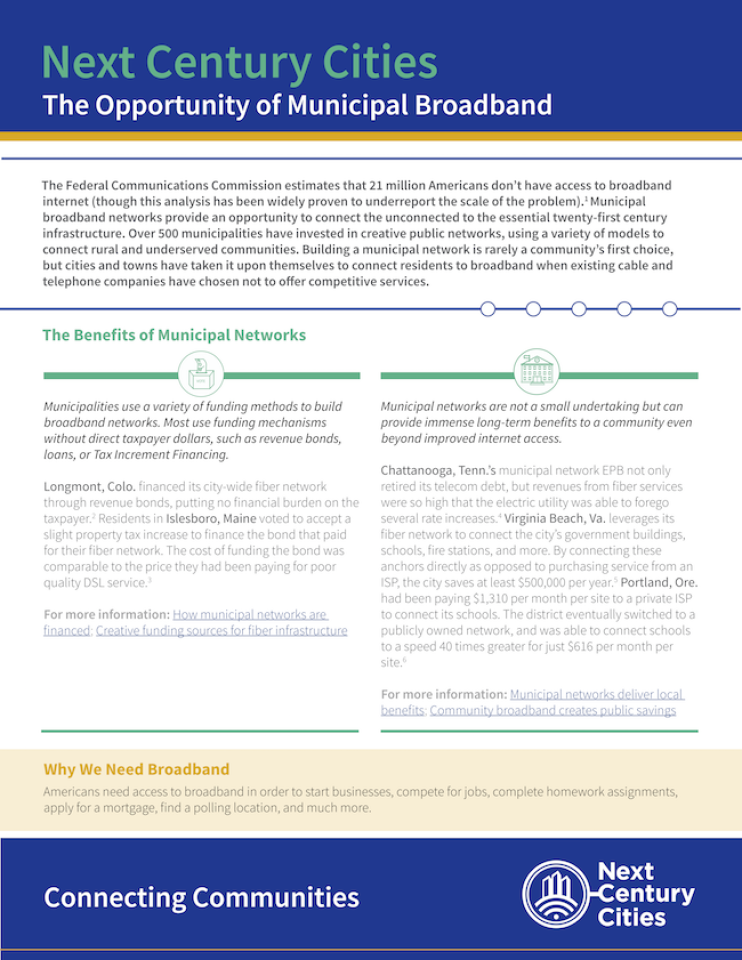
Next Century Cities (NCC) helps communities across the U.S. connect to each other, find resources, and discover ways to improve local Internet access options. NCC’s fact sheet uses examples from municipal network history. Communities have invested in publicly owned fiber optic infrastructure to obtain better connectivity and to reduce telecommunications costs for municipal facilities. In more than a few places, those investments became the foundation for what later became networks to serve local businesses and residences. The fact sheet also delves into other benefits, such as economic development, improved efficiency of other utilities, and accountability.
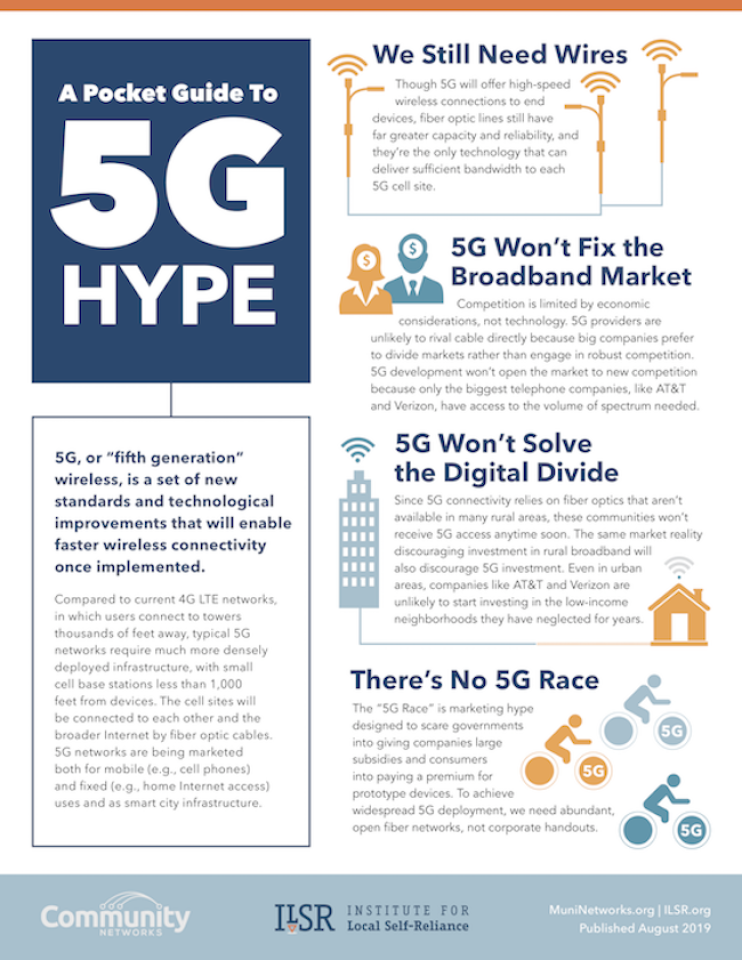
It’s difficult to separate 5G fantasy from reality as reported in traditional news sources. Misunderstandings surrounding the demands and capabilities of 5G has snowballed, creating an incorrect assumption that the technology will solve America’s many connectivity problems. It’s true that 5G is an improvement, but it has limitations. This fact sheet addresses the most repeated errors surrounding 5G and explains why the technology should be considered another tool, not an exclusive remedy.
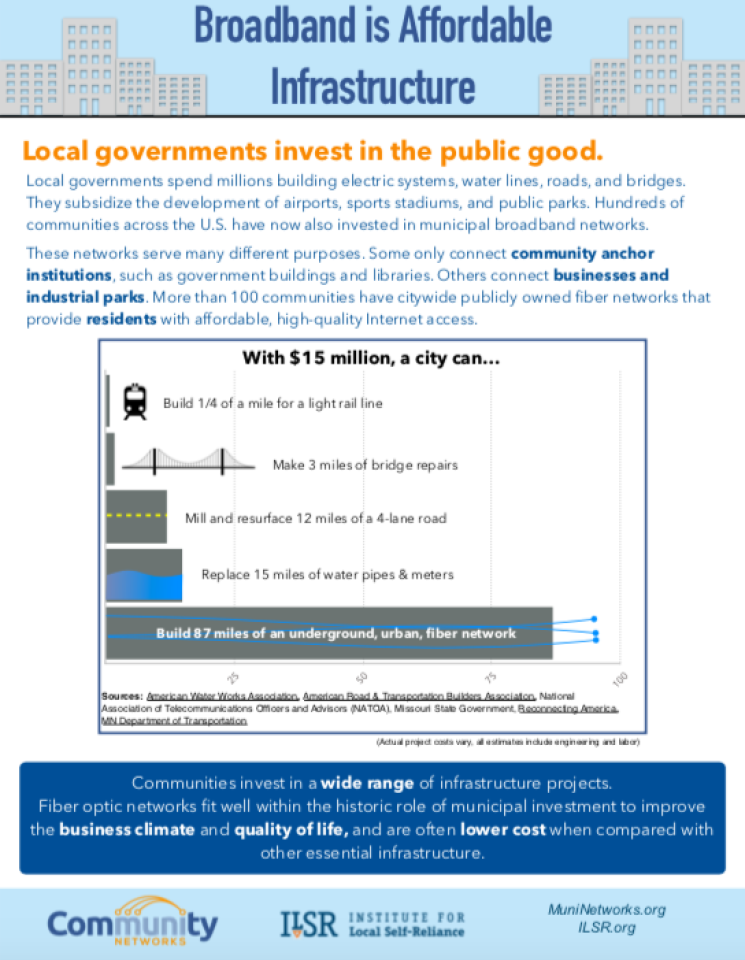
Local governments spend billions on all sorts of infrastructure every year to advance the public good for their communities. Roads and bridges keep day-to-day activity moving. Investments such as water and sewer infrastructure keep cities clean and livable. Fiber infrastructure is used for a wide range of purposes, including economic development, education, and to keep a city’s administration connected. To get a look at how fiber network infrastructure compares to other public investments, we've developed the Broadband is Affordable Infrastructure fact sheet.
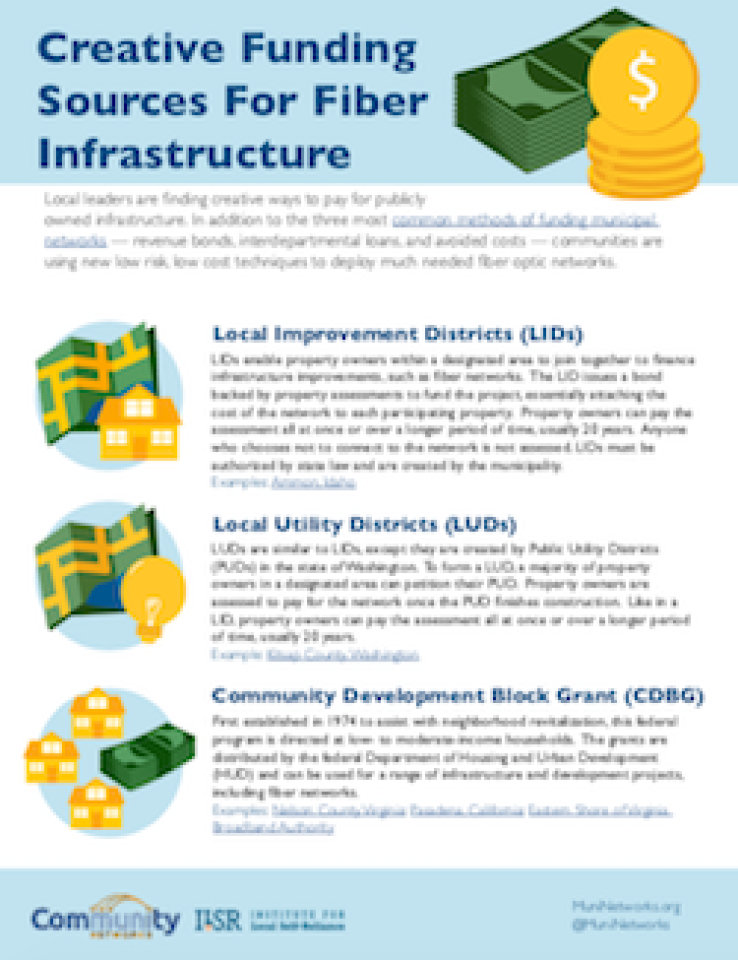
As interest in publicly owned broadband network infrastructure increases, local communities seek new ways to fund municipal networks. Revenue bonds, interdepartmental loans, and avoided costs have been the three most common methods for funding Internet network infrastructure, but local leaders are finding creative approaches to get the job done. In this fact sheet we analyze some new approaches to funding fiber optic infrastructure, pros and cons, and offer some examples.
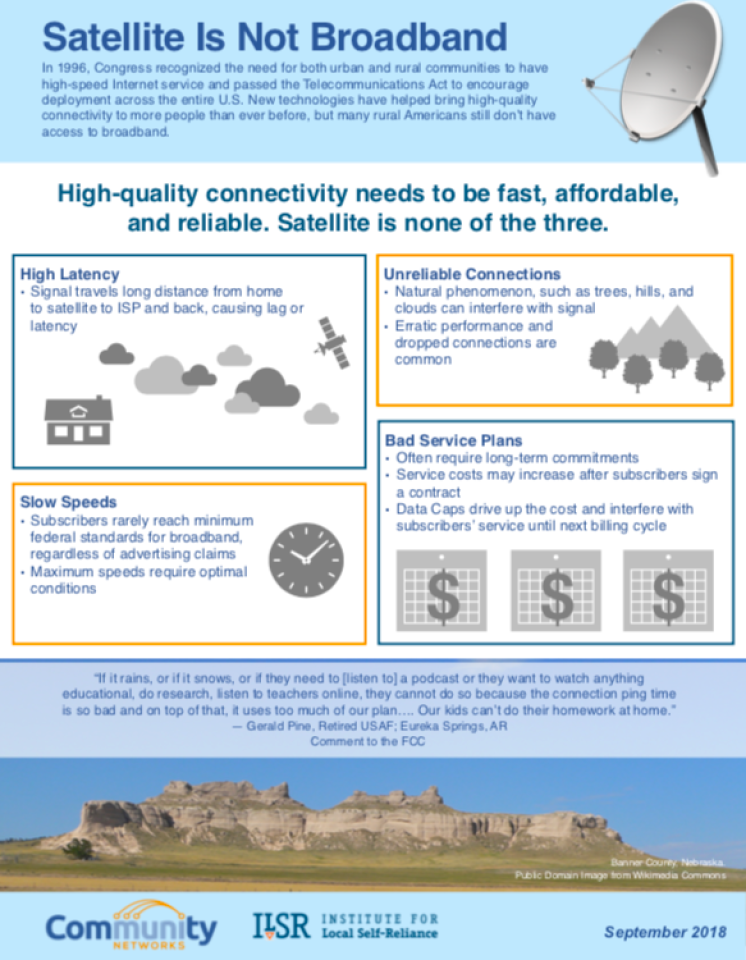
As a nation our goal is ubiquitous broadband coverage so every person, regardless of where they live, can obtain the fast, affordable, reliable Internet access necessary for modern times. For people in rural areas, where large national wireline providers don’t typically invest in the infrastructure for high-quality connectivity, satellite Internet access is often their only choice. In this fact sheet we address some of the reasons why depending on satellite Internet access to serve rural America is a mistake.
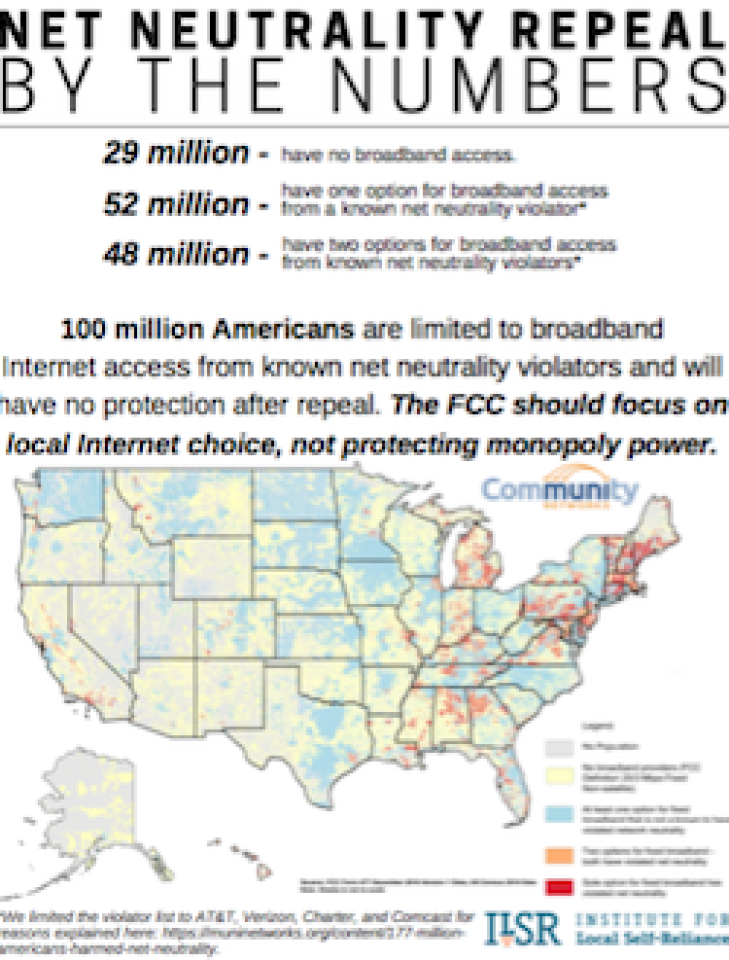
As the vote to repeal network neutrality protections approached in 2017, we started digging into the FCC’s data to determine how eliminating the policy would affect subscribers whose ISPs might take advantage of future changes. We learned that, due to existing monopoly and duopoly conditions, many millions of people would have no recourse but to pay known network neutrality violators for Internet access. We developed visuals and facts sheets with frank data that describes the problem in the U.S., California specifically, and on the East Coast from Maine to Virginia.
Net Neutrality Repeal By The Numbers, U.S.A. Edition fact sheet [pdf].
Net Neutrality Repeal By The Numbers, California Edition fact sheet [pdf].
Net Neutrality Repeal By The Numbers, East Coast Edition fact sheet [pdf].
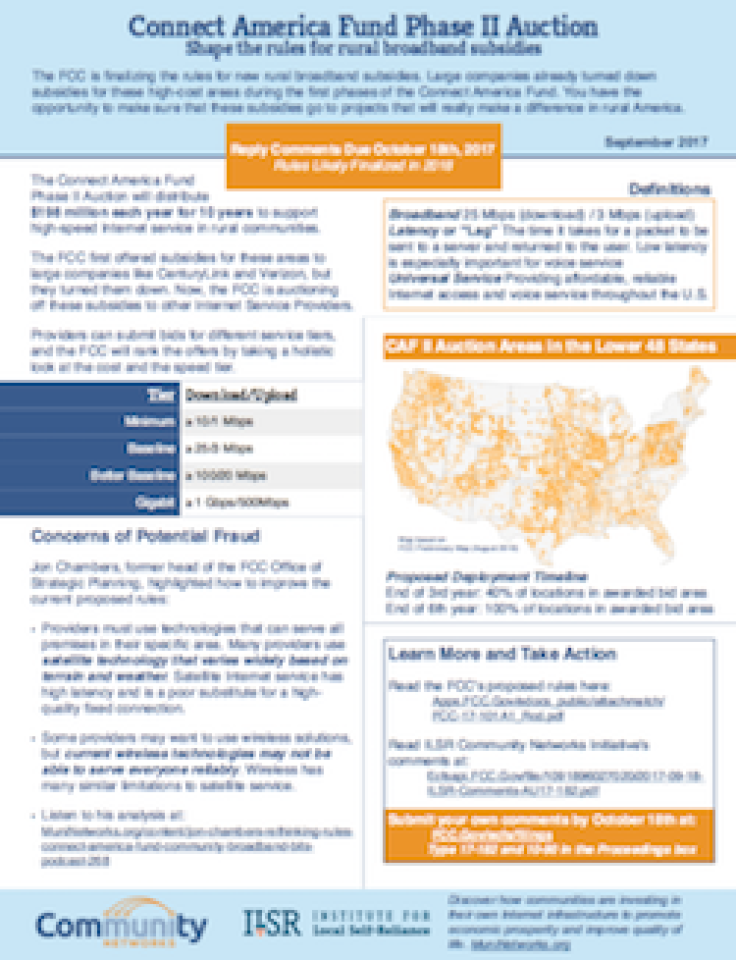
The Federal Communications Commission (FCC) manages the CAF program, which provides billions of dollars in subsidies to Internet service providers for areas where the cost of building networks is prohibitive. Some large providers decided not to accept some of the subsidies during Phase I - about $198 million annually for 10 years. This fact sheet details the most important aspects of the Connect America Fund (CAF) Auction. What is it? What should it do? Who does it affect?
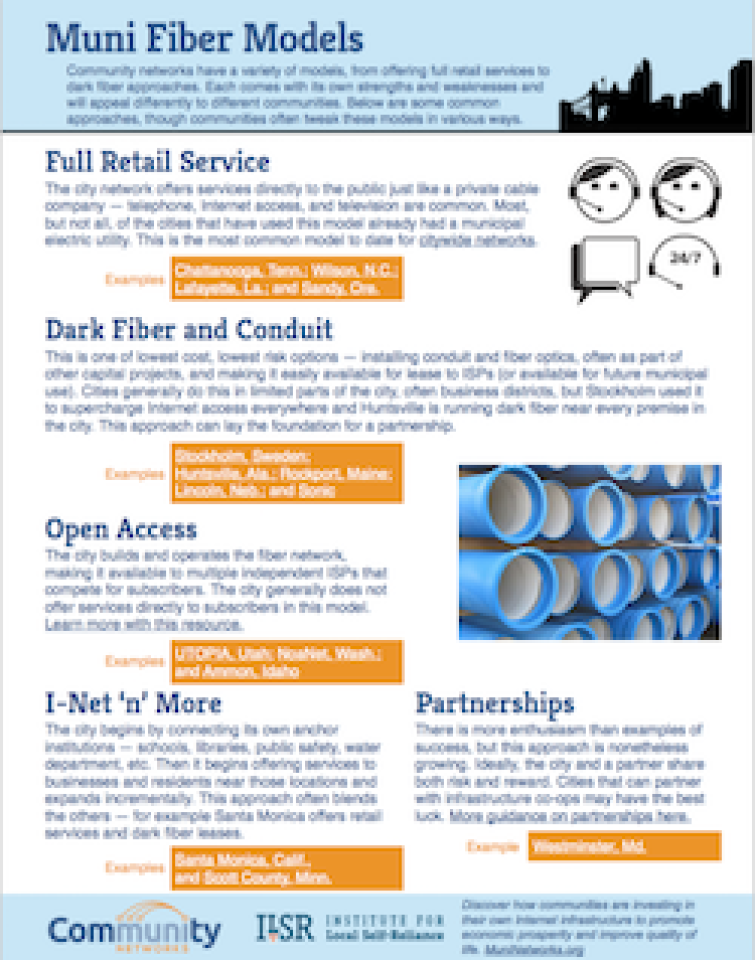
When you think “municipal fiber network,” you may think Chattanooga or Wilson, North Carolina - places where the city utility offers retail services directly to subscribers. That’s only one of several possible models that are emerging as an increasing number of communities use publicly owned assets to improve local connectivity. This fact sheet offers five of the most well known models that local governments are investigating and implementing as they become more self-reliant. Examples and characteristics of each model help illustrate.
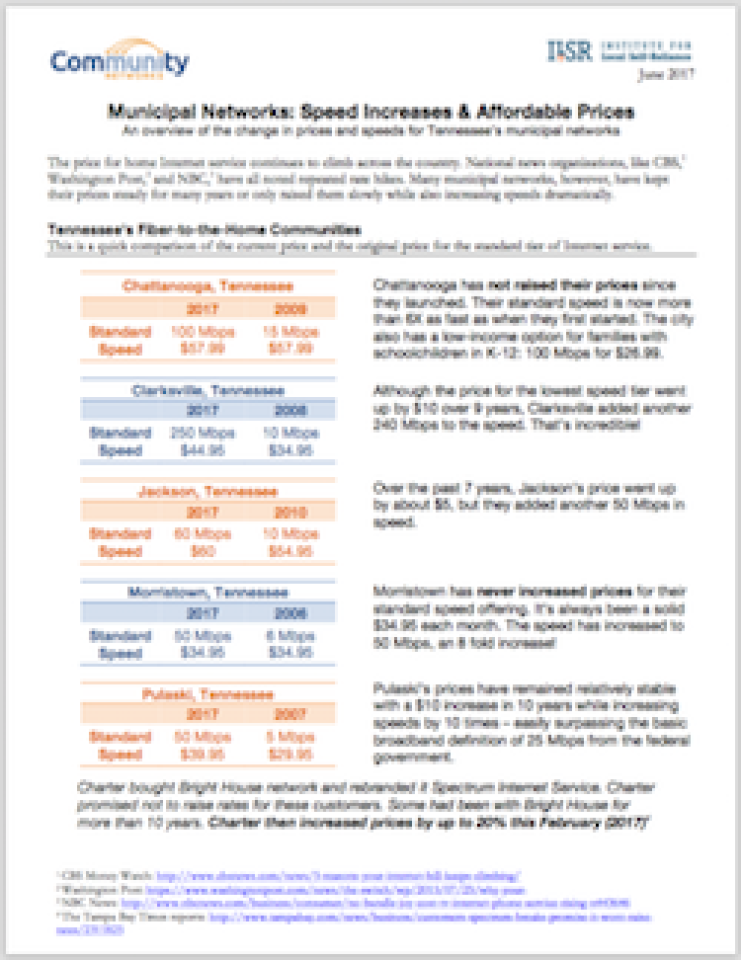
The large corporate national Internet Service Providers seem to raise their monthly rates every year but don’t give subscribers anything more for their money. On the flip side, we noticed that municipal networks tend to increase speeds for subscribers with very modest or no price increases over long periods of time. In order to illustrate this phenomenon, we looked back in time at rates and speeds in eight Tennessee communities that have invested in publicly owned Internet network infrastructure. You will see how speeds have increased significantly, but rates have only inched up.
Municipal Networks: Speed Increases & Affordable Prices [pdf]
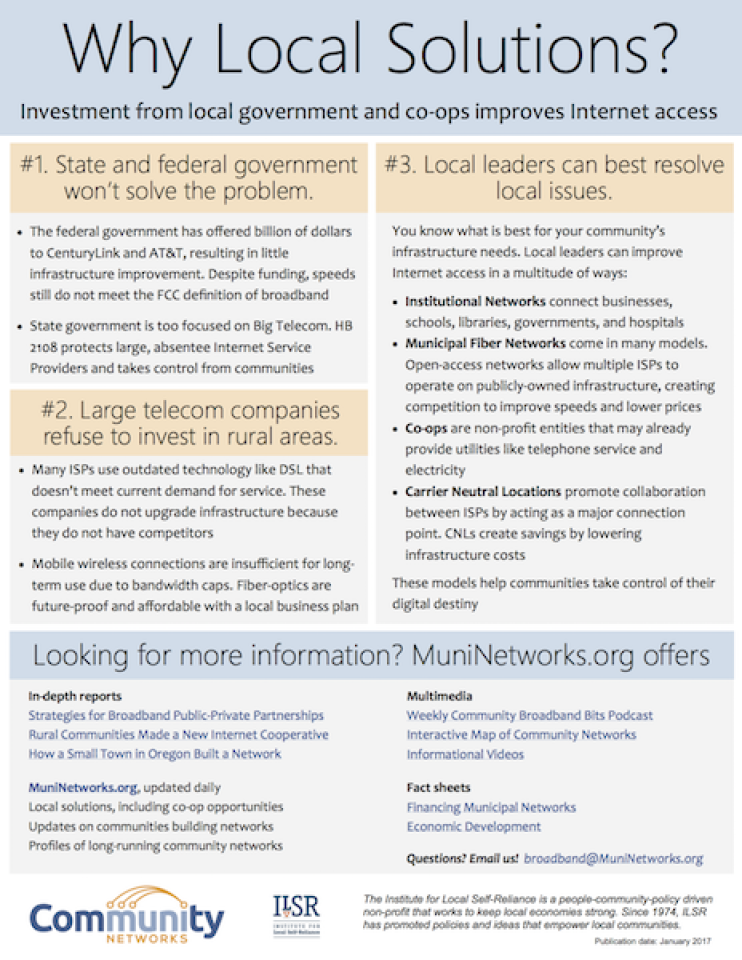
The next time you’re attending a city council meeting, a local broadband initiative, or just chatting with neighbors about better local connectivity, take a few copies of our fact sheet. In addition to providing some basic talking points to get the conversation moving, the fact sheet offers resources to guide you to more detailed information on publicly owned Internet networks. You've already started to get people interested in all the advantages of high-quality connectivity, now show them how local self-reliance it the most direct route to better access.
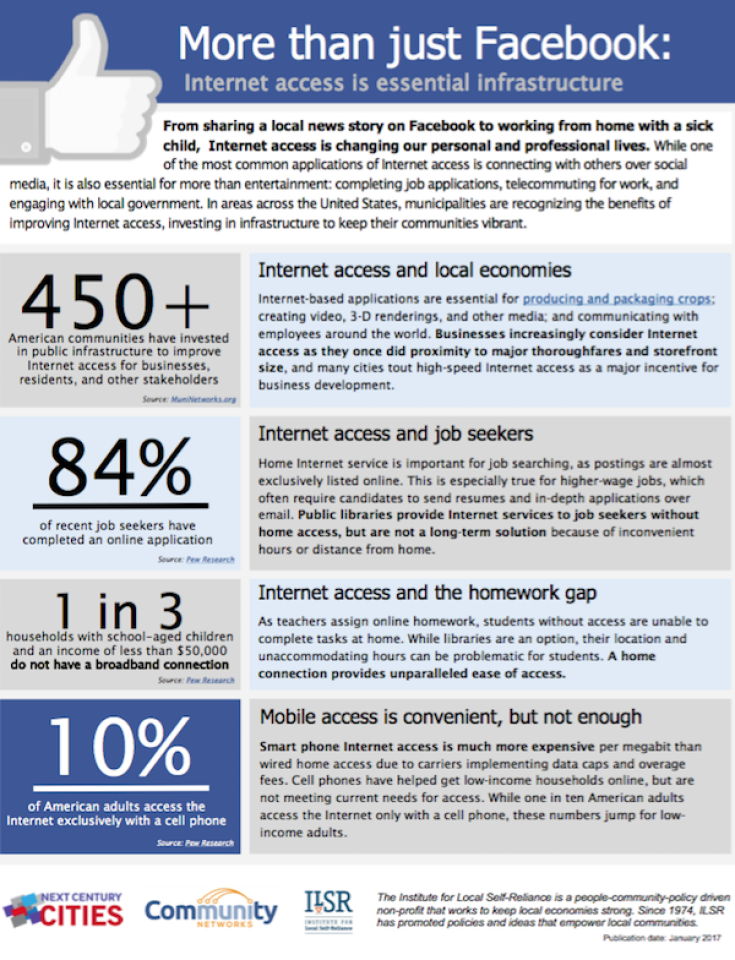
This fact sheet provides an overview on how Internet access and fast, affordable, reliable connectivity reaches most aspects of our lives. It provides statistics on economic development, education, and methods of delivering Internet access and is a good introductory tool that points out how Internet access is much more than just social media.
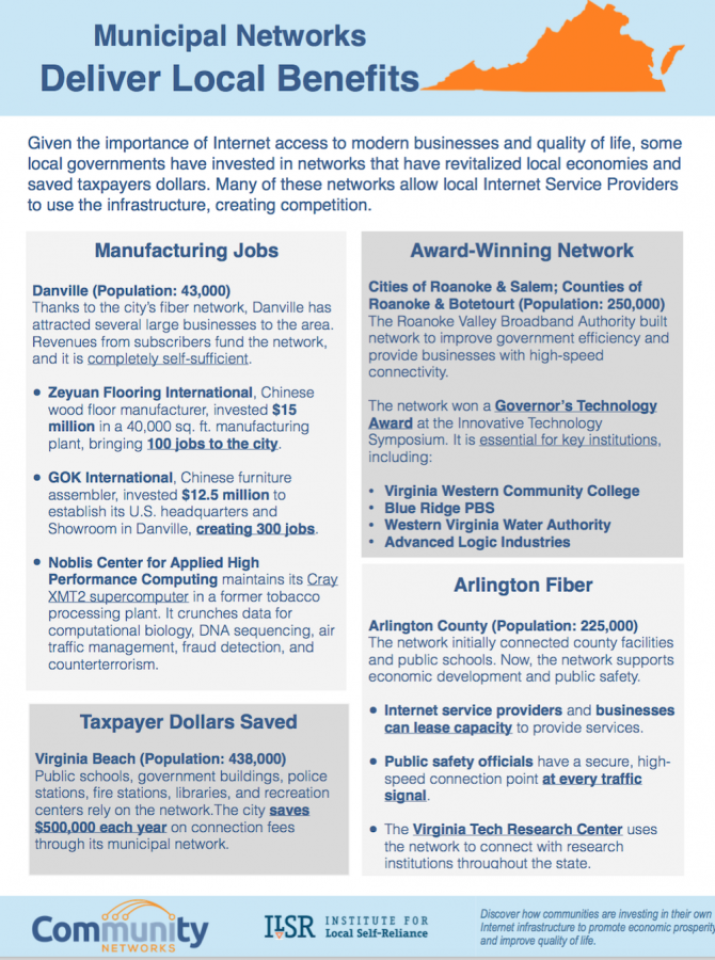
This fact sheet on municipal networks in Virginia describes how economic development, public savings, and better connectivity have contributed to the health of local communities with publicly owned networks. Virginia local governments have improved public safety, healthcare, and connectivity in local schools. Rural areas are better able to compete for high-tech and manufacturing jobs because high-speed connectivity is now an essential service for day-to-day business.
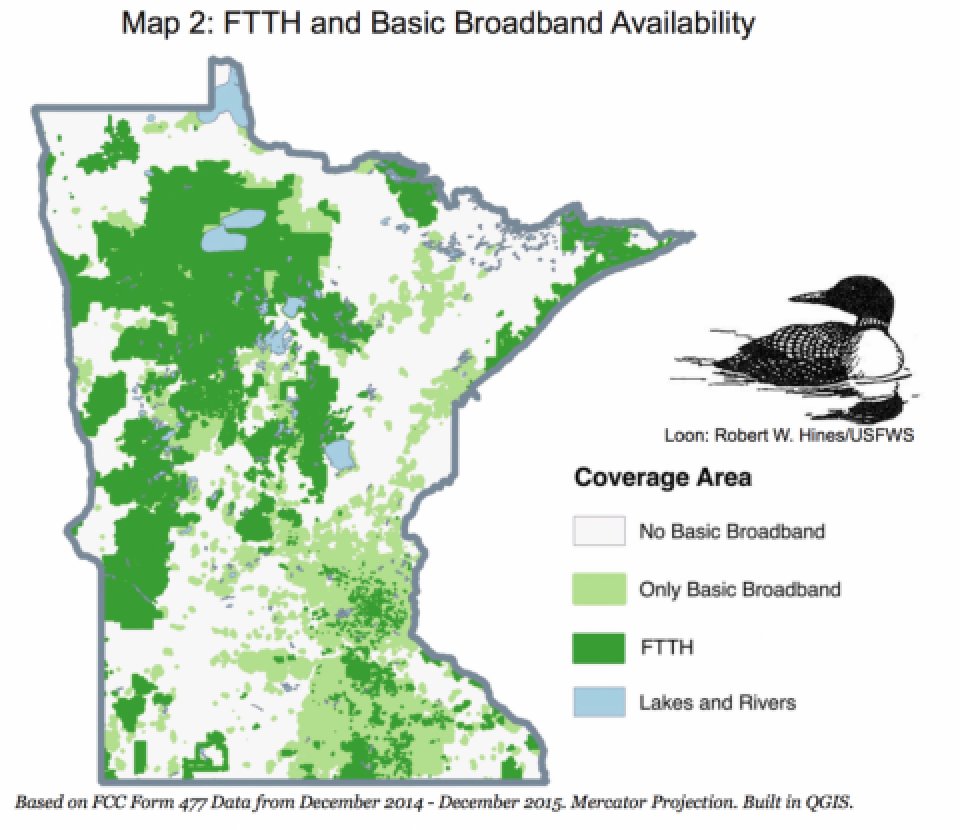
This fact sheet highlights the great work that Minnesota cooperatives and municipalities have done to bring fast, affordable, reliable Internet service to rural areas throughout the state. They've built many Fiber-to-the-Home (FTTH) networks, but there is still much work left to do. One in 4 Minnesotans lives in a rural area, and of those rural households, 43 percent lack access to broadband, defined by the FCC as 25 Megabits per second (Mbps) download and 3 Mbps upload. Resilient, robust, fiber is the long-term goal, but fixed wireless can help extend coverage in hard-to-reach rural areas.
Minnesota Cooperatives and Local Governments Can Solve Rural Digital Divide[pdf]
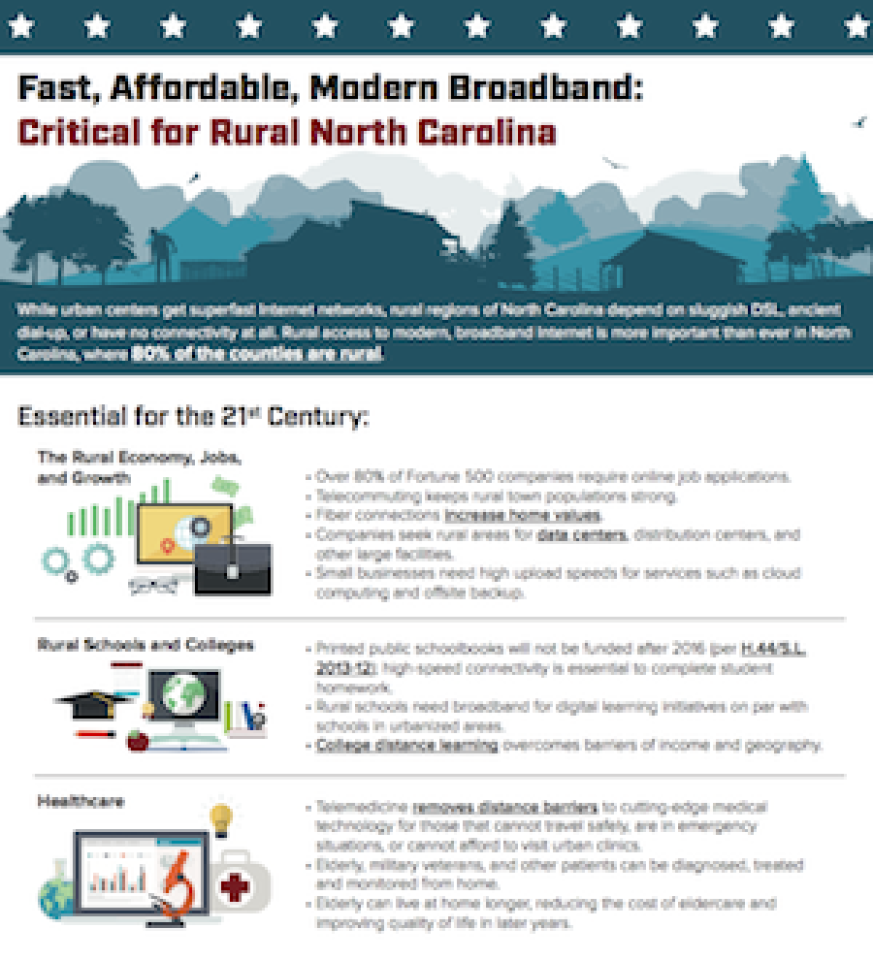
This fact sheet emphasizes the deepening divide between urban and rural connectivity. The fact sheet can help describe why people who live in the country need services better than DSL or dial-up. This tool helps to visualize the bleak situation in rural North Carolina, how it can be improved, and offers links to resources.
Fast, Affordable, Modern Broadband: Critical for Rural North Carolina [pdf]
Communities across the nation have invested in publicly owned cable and fiber infrastructure. ILSR's Community Networks Map documents over 500 communities where municipal networks serve residents and businesses. This fact sheet provides a quick introduction to the interactive online map.
When a community decides it needs to establish its own publicly owned network infrastructure, one of the biggest challenges is financing the investment. Each community is unique but three main methods of financing are most popular. This fact sheet offers a quick look at these common approaches and provides real-world examples.
This is a handy resource for elected officials and activists that are confused by some of the jargon or just want to make sure they understand some key ideas around broadband and telecommunications.
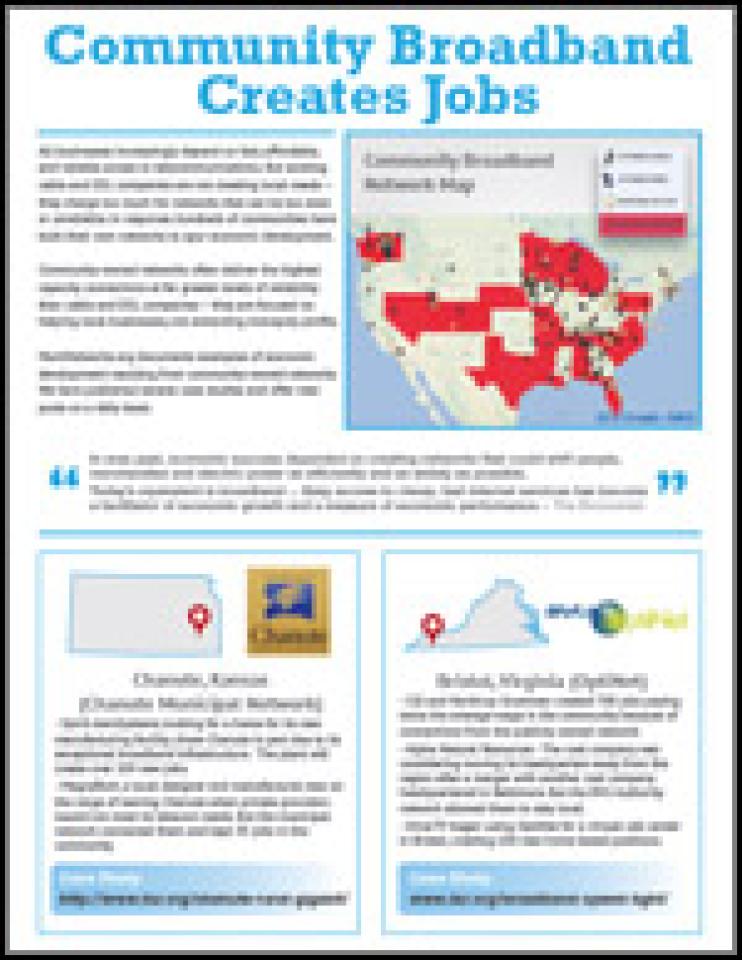
Community Broadband Networks have a very good track record in creating jobs. This fact sheet details where publicly owned network attracted new businesses or helped existing businesses to thrive.
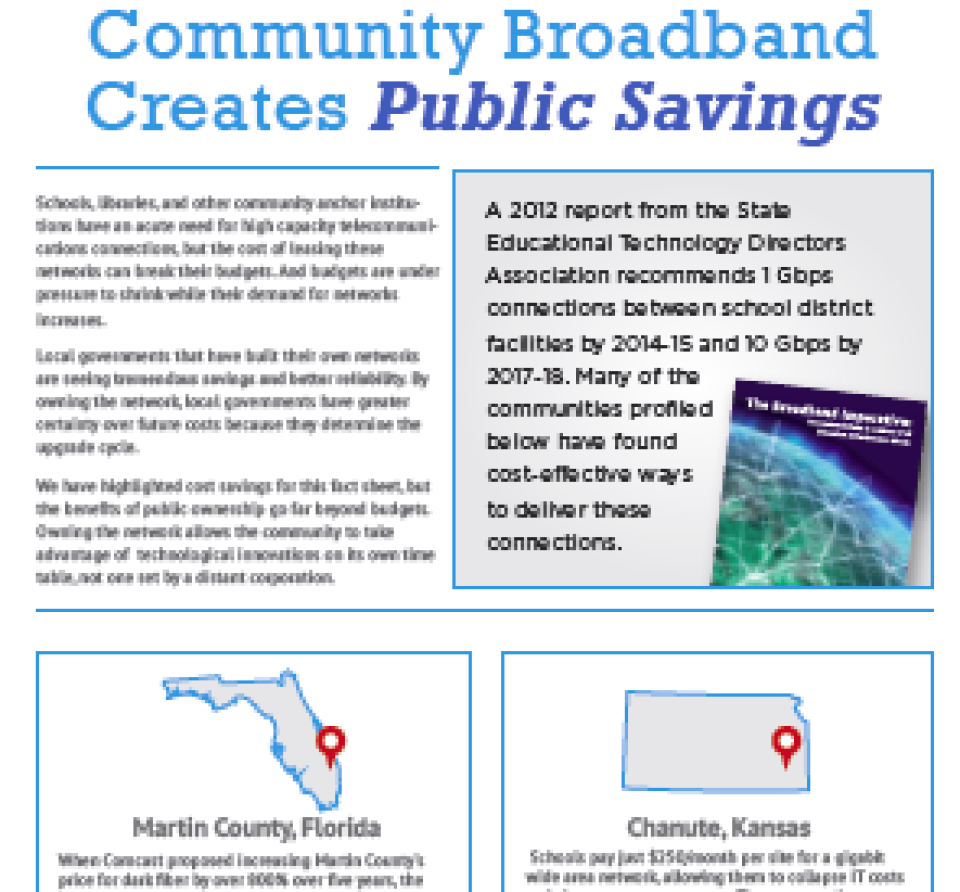
Though schools, libraries, and other community anchors need access to faster, more reliable networks, the big cable and telephone companies have priced those services so high that they are breaking the budget. But when communities create their own connections, affordable high capacity connections aren't the only benefits.
Wireless networks may appear to be magical, but are actually driving investment in fiber optic wires. This resource defines many terms, key points, common speeds, and offers insight into wireless technology and policy.
This 2 page fact sheet explores the issue of preemption - how at least 19 states have made it impossible or more difficult for communities to build their own networks. It includes some history, legal issues, and quotes from FCC Commissioners.
In 2007, the City of Amherst, Massachusetts received a $150,000 grant from the Defense Advanced Research Projects Agency (DARPA) and the National Science Foundation (NSF) to build a wireless mesh network. DARPA and NSF have long been interested in developing mesh networks that are more resilient than traditional hub and spoke type networks.
The City IT Department, UMass Amherst Office of Information Technology Department, DARPA and NSF collaborated to deploy the network that now covers much of the city.
According to GazetteNet.com, the city is now investing another $50,000 to upgrade the system which now extends a mile through downtown. From the article:
“We definitely have the fastest and largest outdoor Wi-Fi network in the state,” said Information Technology Director Kristopher Pacunas.
The new system, which replaces aging equipment that was part of a smaller municipal Wi-Fi system, will be a boon to those who live, work and shop in downtown Amherst, said Pacunas, who anticipates as many as 2,000 different people will use the system daily.
“We’ve seen data in the short time we’ve had this (that) people will come to downtown areas with free Wi-Fi,” Pacunas said.
While the new upgrades were not officially launched until the start of 2013, Pacunas said that over 10,400 people used the system in the weeks leading up to the new year. Pacunas also notes that the network has limited functionality indoors, being designed mostly for public outdoor spaces downtown.
The Town of Amherst Public WiFi website describes how the design was meant to blend in with the look of the city and the light and utility poles that house the access points. There are 30 wireless mesh access points and burst speeds up to 80 Mbps. This is another example of how a municipal network can create direct benefits AND indirect benefits simply through its implementation. Also from the article:
Alex Krogh-Grabbe, director of the Amherst Business Improvement District, said he sees the benefits of the system.
We are pleased to announce that an excerpt of our report, Chanute's Gig: One Rural Kansas Community's Tradition of Innovation Led to A Gigabit and Ubiquitous Wireless Coverage, is now highlighted in the newest Broadband Communities Magazine. The November/December 2012 issue focuses on economic development.
Editors chose our report because it shows how a community can successfully develop a network to address community needs. The result is greater economic development and a range of increased community benefits. In addition to our report, several other articles focus on economic development and come from authors such as Reed Hundt and Blair Levin, Doug Adams and Michael Curri, Ken Demlow, Craig Settles, and David Moore.
You can access the digital edition online and see the entire issue table of contents at Broadband Communities Magazine Online.
You can still download the full report from the ILSR website and check out some of our other resources including case studies, fact sheets, video and audio.
Cottage Grove, Oregon, is on the cusp of adding up to 250 new jobs with the aid of its fiber optic network. A recent Register-Guard.com article by Serena Markstrom details the potential project between the City and First Call Resolution. The company is interested in expanding to a Cottage Grove shopping strip. While the space is the right size and location, it does not have the needed telecommunications connections for a high-capacity call center.
The City is looking into expanding its fiber optic network to accommodate First Call. City leaders will seek a state economic development grant and recently approved funding for an engineer's construction plan to lay the cable to get an accurate cost estimate. Initial estimates are $450,000 for an entire underground installation. Council members have already suggested that the expansion makes sense, regardless of whether or not First Call becomes a tenant. The 7 miles of fiber are primarily located in the southern part of the city while the shopping strip is in the north.
The City Manager Richard Meyers hopes the added infrastructure will bring more than just First Call Resolution to the shopping strip. From the article:
The commercial strip being considered for the call center has much empty space. “The whole plaza needs help,” Meyers said. “We need to do something to see if we can get other things in there.”
If more businesses moved in and started leasing the cable, the city could collect money — just like any utility — from those who tapped into the network and use those funds to continue to expand fiber optic cable around town, Meyers said.
“With our fiber and what we’ve developed, we’re within 4,000 feet of connecting” to the Village Center, he said. “That’s how close we are,” he said. “It’s not a huge distance. We can do it. (It would be a) piece of cake to connect our system to his network and so all of [First Call Resolution's] call centers would be on the same network.”
The city network also offers a Wi-Fi network throughout 80% of the city. Rates vary, ranging from 10 free hours each month at 128 Kbps to 7 Mbps unlimited with tech support for $50 per month. According to the CGWiFi website:
Since 2008, we have followed and reported on the peaks and valleys that is UTOPIA. Recently, the Salt Lake Tribune ran a series on the regional network. The coverage includes a sampling of the bitter and sweet of the complex relationship between the pioneering network, the state, and the customers it serves.
As many of our readers know, UTOPIA is mired in debt and endless political controversy as Comcast and CenturyLink fund "think tanks" to attack it. Tony Semerad from the Tribune talked to our own Chris Mitchell:
"When you build a network like this, it takes a minimum of several years of spending a lot of money before you start to get it back from your customers,’’ said Christopher Mitchell
As Christopher goes on to note, a large debt from the beginning to create an open access network is not a favorable situation. Additionally, past management made choices that still negatively impact the network. Constricting legislation at the state level prevents the network from expanding to a more profitable retail market, weakening it even further. Also from the article:
State law requires UTOPIA to operate as a wholesaler, a limitation conceived at UTOPIA’s inception when telecommunications giants such as CenturyLink and Comcast, now called Xfinity, grew wary of plans by Spanish Fork and Provo to get into the cable television business and lobbied state lawmakers for protections.
Some communities express derision at the situations they face regarding UTOPIA, having been left with debt and not yet received the ubiquitous access they anticipated. Some communities, who are still waiting for better subscriber numbers, already see improved economic development and remain patient. Connected communities vary in their satisfaction and level of support: